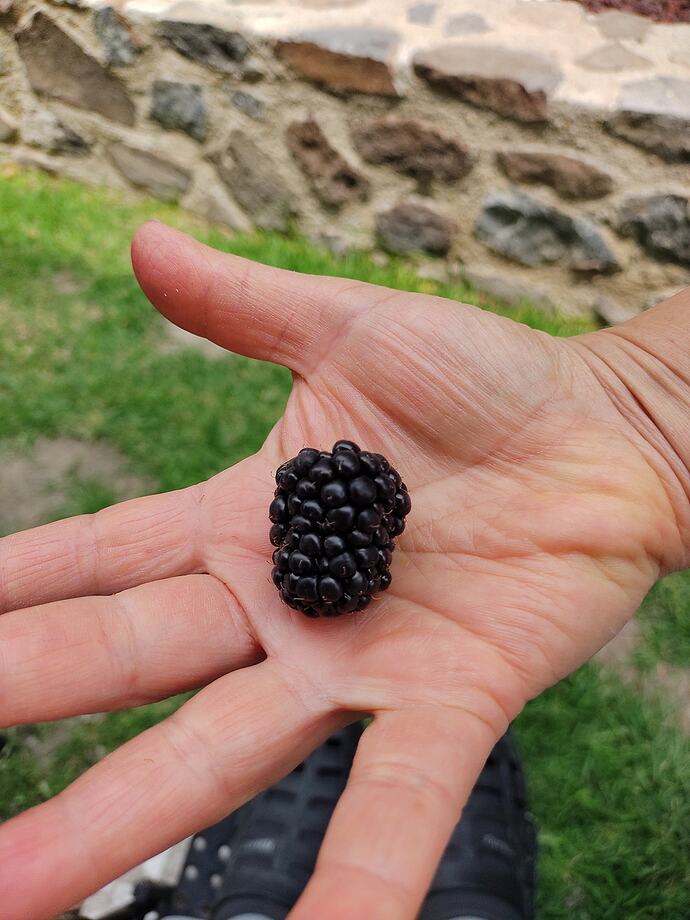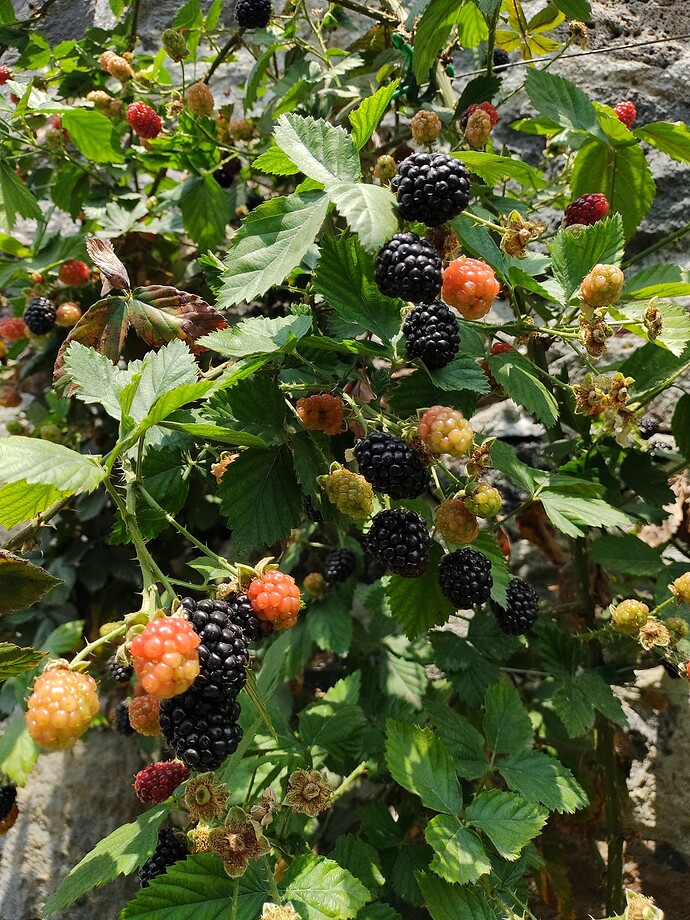That’s a very interesting description. I can’t even imagine. Overall, did you enjoy it?
Yes! I can send you a start in the spring of next year when they really start growing again. Right now, i only have a few canes and they don’t seem to be popping up new ones as much as my other reds.
Growth has been slow lately with the rain and cold weather but they’re still going.
If you leave them on a few days after they turn bright red, they get sweeter. 2-3 days is my max ![]() they taste perfect then.
they taste perfect then.
I bought a few Vintage plants this past summer. The flavor is close to Caroline.
That article states that Canadice is susceptible to root rot, but my experience has been the opposite. I was growing Heritage, Fallgold, and Amity primocane varieties years ago, and they were all dying after a few years, presumably from root rot. I replaced them all with the offspring of a single Caroline plant; and all of these replacements have been growing well for over 20 years in the same locations.
Another thing that I noticed, is that all red raspberry varieties seem to resist root rot better if they are mulched with wood shavings.
I wonder what the growing conditions look like in that study because a lot of big varieties come out as small ![]()
Interesting.
I will be able to review the Vintage primocane crop in 2026 and floricane crop in 2027 as i just planted them this fall. Not much that i plant year 1 is worth reviewing and i think I and @TNHunter remove all first year growth as its not worth the energy or resources to continue into year 2.
I think @TNHunter has shown us that Heritage is good for him as a floricane crop due to early ripening. Which is why he removes his spent canes early. If he chose to harvest the primocane crop he would be picking in August thru October which i think he avoids due to SWD.
So some of these primocane fruiting rasps are better grown for some as mostly floricane producing.
Peak harvest of Vintage raspberry primocane is first week of October in its prime. So a review of the fruit at its prime in summer must have been the floricane crop.
Several cultivars can have larger fruit earlier than others… Joan J is a good example as it is early maturing. Whereas some are not early maturing and will have much smaller berries until they are more mature.
@krismoriah … I do double crop my heritage reds.
Get a very nice abundant harvest for about a month in the spring on florocanes.
Get a nice long less intense harvest on pcanes in the fall… Aug to Nov normally.
I do have to remove my spent fcanes once they finish fruting… to slow a funky brown spot issue… that can spread to my new pcanes… and cause leaf drop.
TNHunter
With my increases in SWD and RCB… i think eventually i will be out of the pcane business for my hobby farm. Maybe something will change but its becoming a challenge and early fruiting things are more desirable to me now. I am out of the pcane business on blackberries altogether here now except for Black Gem and Black Magic and Sweet Giant as i am trialing them for fcane instead. Most all of the others ripen way too late for me here on pcanes… and are a waste of time and energy so i think i will just start snipping the tops early and try to grow for early fcanes instead.
ive only got swd in stuff that ripens july- aug here. havent seen any in my primocane fruiting ones yet. they hit my Colombia giant and prelude fruit last summer. i didnt get around to spraying. if i spray just before the flowers open it almost eliminates them completely. in years there are a lot of hummingbirds around there are very few swd. they absolutely love them! ive witnessed them snatching them out of the air all around me when im disturbing the canes . sort of starts a feeding frenzy. they zip by me by inches sometimes.
If you don’t mind me asking, what state are you in?
I’m seeing 6b and i was thinking of how late you say primocanes bear for you. It’s got me wondering ![]()
When i was in Colorado Springs/6b, i could never ripen figs but was able to ripen Passion fruit. The primocanes for me ripened in July/ August but i pushed for it.
I haven’t found earlier ripening times to help much with SWD over here. Since there are no wild blackberries, they don’t get massive population spikes from that. I’m finding their entire population seems to rely purely on my own plants. Instead of a defined season, they simply appear whenever there’s berries. They’re thick for strawberries, and again for blackberries. The more fruiting stuff, the more maggots.
im surrounded by fields of wild raspberries here that ripen mid july. when the swd and cane borers show up.
WV… not really sure if i am 6B or 7A… i guess it depends on mother nature and what she wants to do. TNHunter lives in a milder climate than me and his Loganberries were zapped whereas mine werent. I havent had many issues with any of my brambles except for some of the PrimeArks and Ponca that got the most winter damage but im not a big fan of them anyways… so i must have some kind of microclimate.
I am surrounded by dense forest so my SWD overwinters in native trees and leaf litter etc… no way for me to overcome them. Alot of folks blame native brambles etc but for me thats not the case i dont think.
I have lots of hummingbirds but i think going forward my best hope is wasps… and hornets.
Im not sure that there is much information about that…but i have witnessed it alot here. Most folks hate hornets and wasps but i have seen them being voracious predators of my larvaes.
Been spying some blackberries along my fence row, finally got around to digging up and planting them in 3 gallon grow bags.
Placed them in my greenhouse. Any advice for a novice grower?
I think it’s better to get the named varieties so you know at least what you’re growing and the growth characteristics.
But thats me though. I’ve become a crone for wanting to know all my plants and how they grow/ what they’re good at.
Is there any consensus on the hardiness of the primocane blackberries? I already have a few varieties of thornless blackberry here in zone 6 NY, but I was thinking I could have room for one more next year.
Has anyone grown them well without much dieback in colder climates, or have you just mowed em back and grown solely for the primocane rather than floricane crop?
As far as social medias are concerned… you will see most of the prime-arks being photo bombed and adored in May/June/July those would be floricane fruits depending on climate. Optimal climates will give the earliest fruiting.
As for the primocane fruiting… U of Ark admitted that fruiting depends on tipping management and that its an issue with the lateness of ripening due to early frosts in areas colder than Arkansas.
So to answer your question… is complicated.
In order to get a good primocane crop aggressive early tipping is needed… That will in turn give shorter plants… after that crop is finished that portion of the cane is spent… So that portion of the cane will be removed… its hard to know at that point what gets cold damage and what is actually spent cane… at least to me. By the time all is said and done you end up with a knee high cane for the floricane crop. As far as i can tell the only way to get a substantial floricane crop is to prune out the tips once they bud… or like i have discussed before… let the plants get 10 feet tall and then you will at least have 5 feet of floricane to work with. That method gives very small yield on pcane… which in turn for me usually gets frost zapped.
So for me i dont have much interest in blackberries in as early as August or late as November… so that rules out the desire for primocane fruits. However the floricane crops are some of the earliest which that does interest me.
YMMV… but thats how it works for me as i understand it.
Thanks for the info. Early floricane crops wouldn’t be a bad thing, at least to stretch out the season a bit.
I did something similar lately:
- I found a wild blackberry (or dewberry?) seedling sprouting up along the edge of a golf course, so I went back at night with a spade and dug it up and planted it in a container

- I also went on a nature walk on some trails in Wimberly, TX, and found some long blackberry vines growing along the ground - and pulled one up roots and all and took that home and planted it in a container too (found at approximately 29.882499463399462, -97.97974212489518)
I have no idea if they are even self-fertile, but I’ll let you know what happens!
I will take pics next year but i found a few myself. I believe they are variations of Himalayan which i have found nearby.
If you have pollinators in March/April. you could have very early ripening Himalayan which can be tamed to a trellis.
These pics were taken first week of May in New Mexico.
Mine here are very ornamental and unless it gets way below zero they do not lose their leaves… they get much darker green.
I have about 10 plants in a test plot that stays waterlogged and bogged. They are doing fantastic so far.
I saw one cane that was nearly 3-4 inches in diameter in a reclaimed area on the KY/WV border… and canes were about 20 sum feet long. No other bramble compares in size and resilience that i know of.


